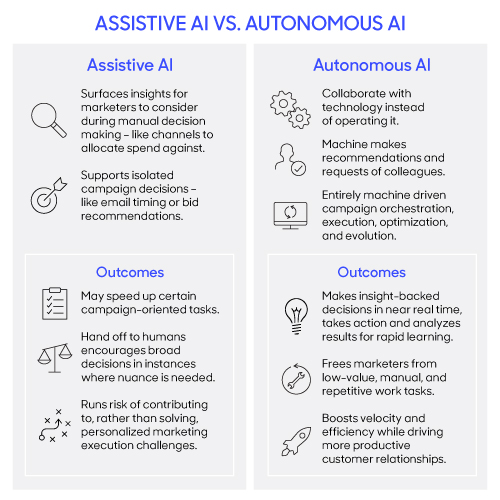The once-clear boundaries between brands and retailers have faded. Brands have learned how to be retailers, and retailers find themselves in competition with the very brands they carry, which are now selling directly to consumers.
This has resulted in an e-commerce marketplace with twice as many sellers as there were just 10 years ago. Consumers are overwhelmed with choice. The price of customer acquisition has skyrocketed. And with so many touch points across devices and channels, brands and retailers can barely keep up.
This complexity and the resulting deluge of data is too daunting for humans to handle alone, but it presents an ideal environment for machines. Having worked with pretty much every kind of direct-to-consumer (D2C) brand as they turn to artificial intelligence (AI) to handle different aspects of their customer acquisition and paid digital marketing efforts, I’ve identified three distinct learning curves that marketers inevitably encounter along the way.
1. AI thinks in terms of micro-personas, not buyer personas
Not all AIs are created equal, nor do they all do the same thing. Some AIs surface insights for humans to act on, while some act on those insights autonomously. But none of them act like a know-it-all. Successful D2C brands and e-commerce marketers have often done a ton of work to identify and get to know their audiences, which AI will likely confirm, but in seeking growth, they shouldn’t limit AI to their knowledge alone.
Given the chance, an autonomous marketing AI will explore every nook and cranny of the channels it’s working in to uncover opportunities and audiences in its own way. While brands might define their audiences in the form of several distinct buyer personas, complete with psychographics, AIs generally creates thousands of micro-personas. Examples of this might include “people who search for diamonds online respond to motorcycle ads at a disproportionately high rate,” “men who identify as engineers on Facebook are engaging 300% more with jeans ads than those in other professions,” or “men over the age 65 in Sydney, Australia, who like to go flying are likely to buy experiences as gifts for friends and family.”
Often times, these micro-personas don’t fall neatly into existing buyer personas, which presents brands with an opportunity to gain an understanding of the long tail of their customers. While it can be tempting to reject these new audience types as inherently “wrong,” AI reaches statistical confidence much quicker than a human does.
Marketers can use these insights in many ways. The most immediate would be to introduce micro-campaigns for high-potential micro-personas. Such a campaign might consist of highly targeted visuals and copy tailored to resonate with these niche audiences on a granular level. Upon clicking on a promotion, these consumers could be taken to a dedicated landing page, designed and populated with content specifically for them, resulting in a consistent experience and narrative, from initial ad engagement to the brand’s site.
2. Different rates of creative fatigue mean that testing and learning take on new importance
Direct-to-consumer marketers are constantly surprised to learn how quickly consumers suffer from ad fatigue. In other cases, they’re surprised to discover creative exceptions that continue to work profitably long after brand managers think the ads should be retired.
If you’re a part of a retailer or brand that’s using AI in digital advertising, then you need to make sure you have strategists on the team who can understand what’s working, what’s not, and why, and provide appropriate direction to creative resources who can then produce content (images, videos, headlines and captions). And since AI targets hundreds to thousands of micro-personas, rather than only a handful of buyer personas, brands are able to test every idea they can come up with to personalize their efforts to a far more varied consumer mix.
3. Autonomous doesn’t mean … autonomous. Don’t forget to implement your humans
Left to its own devices, AI will focus purely on making data and technology decisions that lead it to the goals it’s given. Brands are great at setting revenue or customer acquisition targets, but it is important to have an AI that can accept various kinds of guardrails. Without established boundaries, some of the decisions an AI will make in pursuit of meeting its goals might be off-brand, appear ill-informed or just seem odd to the consumer on the receiving end.
Take, for instance, brands targeting very specific markets (such as those selling warm-weather clothing during the winter), buyer types (e.g., luxury shoppers) or demographics (baby products or men’s shoes). In the case of a luxury marketer, the AI might discover that a discount offer is performing particularly well and therefore scale the use of the promotion to meet its acquisition goals even quicker. But the brand, not wanting to be viewed as a discounter, will likely see this as a brand positioning fail.
AI also doesn’t know it should be showing a dedicated creative set on holidays; it only knows what creative is converting. It doesn’t know which topics are sensitive; it only knows that some topics attract more visitors than others.
There are also more nuanced kinds of considerations that human strategists must share with AI. For example, a customer of ours, a direct-to-consumer sustainable meat and fish grocer, finds that when there is mention of a food recall in the news, consumers become more aware of their food choices. AI isn’t tuned into the news and wouldn’t know about a salmonella outbreak, so it relies on its human colleagues to equip it with specific messages that cater to consumers looking for information about what they’re putting in their bodies.
Long story short, even artificial intelligence needs human insights and strategic guidance to be successful. And while AI might discover new high-potential audiences, it’s up to the brand to determine its approach to interacting with and engaging those audiences.
Brands that set up guardrails and master the art of collaborating with a machine rather than simply operating it can then let the machine run free to do its job.
Article previously featured in Forbes, What D2C Retail Brands Need to Know Before Using AI For Customer Acquisition, April 17, 2019




